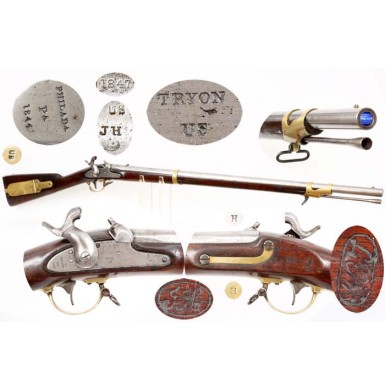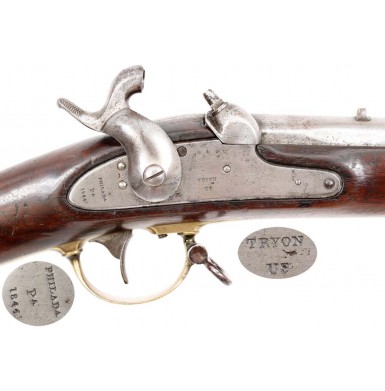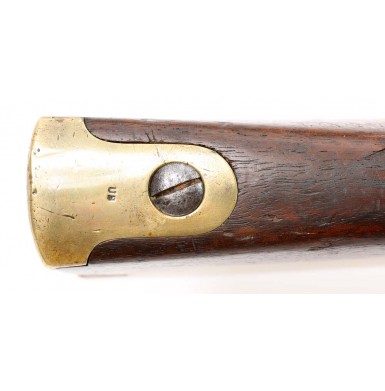This is a VERY GOOD+ example of a US M-1841 Mississippi Rifle from the smallest and least often encountered contractor to produce these guns. This rifle was produced by the Tryonmanufacturing company of Philadelphia. Between 1844 and 1855, a total of 92,807 US M-1841 Rifles were produced by the National Armory at Harper’s Ferry, and by five contractors. Harper’s Ferry produced 25,207, or about 27% of all of the guns. Of the five contractors, the Eli Whitney Jr. Arms Company produced the largest number of M-1841 rifles delivering 27,600, or about 30% of the total production. Robbins & Lawrence was the second largest provider, producing 15,000 guns between 1848 and 1853. Their output represents about 16% of the total production. The firms of E. Remington & Sons and Robbins, Kendall & Lawrence (predecessor to Robbins & Lawrence) both delivered 10,000 arms, or just shy of 11% of the total production. The firm of George W. Tryon of Philadelphia produced and delivered only 5,000 arms, which was only about 5% of the total production. Tryon appears to have received his contract due to a request from the state of Pennsylvania that noted they preferred to receive arms produced by Tryon in their allotment of rifles due yearly under the Militia Act of 1808. Due to the state interceding on his behalf, Tryon received the very first of the US M-1841 Rifle contracts. The US M-1841 Rifle had its genesis at Harper’s Ferry in March of 1839. During that year, the Master Armorer, Benjamin Moor, was asked to design a new percussion ignition rifle to replace the current M-1817 “Common Rife”, which was a flintlock design. The percussion ignition system was still in its infancy within the Ordnance Department, and at the time Moor was asked to undertake the new rifle project, all US military arms were flintlocks, with the exception of the M-1833 Hall-North Dragoon Carbine that was being produced by contractor Simeon North and the M-1836 Hall Dragoon Carbine produced at Harper’s Ferry. Among the specifications set forth for the new rifle design were that it was to be manufactured on the principle of interchangeable parts, a process that had first been adopted at the Harper’s Ferry Rifle Works, where John Hall’s breechloading flintlock M-1819 Hall Rifle had been in production since the early part of the 1820s. After the initial rejection of prototypes supplied during 1840, a final version of the new US M-1841 Rifle was adopted around March of 1841, and that year 8 “Model” (sample) rifles were produced at Harper’s Ferry, along with the appropriate inspection gauges, production jigs, etc. One of these guns was sent to the Springfield arsenal to provide guidance in the design of what would be the US M-1842 family of percussion arms, including the musket, cadet musket and pistol. The US M-1841 Rifle, as adopted in the spring of 1841 was a .54 caliber percussion ignition, muzzle-loading rifle that had a 33” barrel that was rifled with 7 deep grooves with a 1:72 rate of twist. The gun was designed for use with a patched round ball, and predated expanding base, Minié pattern bullets. The rifle was 48 ¾” in overall length and in keeping with the traditional belief that riflemen were specialized troops and not “line infantry” it was not designed to accept a bayonet of any sort. The rifle had a fixed, V-notch rear sight and a brass blade front sight, and was graduated for point of aim at a very short 50 yards, relying upon the skill of the rifleman to shoot accurately beyond that distance and adjust his sights and hold appropriately. The rifle was one of the most attractive to be adopted by the US military during the 19th century and featured a case hardened lock and hammer, a browned barrel and brass furniture (barrel bands, patch box, buttplate, triggerguard and side plate). The small parts like screws, sling swivels and barrel band springs were blued. The first issue of the M-1841 for significant combat use came during the Mexican American War of 1846-1847, when the 1st Regiment of Mississippi Volunteers, under the command of Colonel Jefferson Davis were issued the rifles, making them the only significant issue of percussion arms to see use in Mexico, with the exception of the previously mentioned Hall carbines. Davis’ men used the rifles to such great effect during the battles of Monterey (September 21-24, 1846) and Buena Vista (February 23, 1847) that the guns received the nickname Mississippi Rifles, and would forever carry that moniker. As a sign of thanks for the good work that Davis’ men did with their percussion rifles, the state of Mississippi allowed the men to keep their rifles after the war, and a total of 363 rifles went home with the 1st Mississippi Volunteer regiment. It is likely that some of those arms saw use again during the American Civil War. Delivery of the M-1841 Rifle was initially quite slow, with Tryon and Whitney being the only contractors to deliver any arms during 1844. Both delivered 600 rifles that year. In 1845 the Harper’s Ferry Arsenal delivered 1 rifle, and Tryon delivered another 600, with Whitney delivering 1,200. In 1846 Harper’s Ferry delivered 700 rifles, Tryon 900 and Whitney 2,400. As the arms issued by the state of Mississippi would have been contractor produced, rather than national armory produced (pursuant to the Militia Act of 1808), that means the Mississippi Volunteers were armed with either Whitney or Tryon rifles. Assuming that only those guns delivered to the Federal Government in 1844 or 1845 could have been in the Mississippi state arsenal in 1846, this means of the 3,000 contract rifles delivered in 1844 and 1845, 60% of them (1,800 of the 3,000 total) were Whitney guns and 40% (1,200) were Tryon arms. Tryon would continue to deliver arms under their initial 5,000-rifle contract through 1849. In April of 1848 they received a second contract for 5,000 rifles but George’s son Edward, who had taken over the business, felt that they could not produce the guns and requested this additional contract be transferred to Eli Whitney Jr. Due to their inability to handle the second contract, Tryon only produced the initial contact of 5,000 rifles, making them the least commonly encountered of the US M-1841 Mississippi Rifle variants, and one of the most desirable for collectors.
This particular Tryon contract US M-1841 Mississippi Rifle is in about VERY GOOD+ condition and appears to be 100% complete and correct in every way, with the exception of a replaced sling swivel and a later period original ramrod. While the majority of Tryon marked M-1841 rifles that are found today are really only Tryon locks that have been put into Whitney or other contractor produced guns, this one is all Tryon; lock, stock and barrel. The rifle is clearly marked on the lock in two horizontal lines, forward of the hammer: TRYON / US and in three vertical lines behind the hammer: PHILADA / PA / 1844. The date on the barrel tang is quite legible, and reads 1847. It is not uncommon for lock and barrel dates and lock dates to be off from each other by one year as a result of older parts being mixed with newer parts during assembly. However, being off by three is a little unusual. However, as the barrel is verifiable as a Tryon barrel I am not nearly as concerned. The breech is crisply and clearly marked with a correct set of inspectors marks for a Tryon contract gun: U.S. / JH / P. The most important part of the markings is that the “P” proof is in a depressed starburst and this mark only appears on Tryon contract barrels, and not on any other contract M-1841 barrel. As there were at least four US sub-inspectors with the initials “JH” working during the mid-late 1840s I am not sure if the “JH” barrel inspection represents Joseph Hannis, James Harris, John Harkins or Joseph Harniss. However, the left side of the barrel and the brass side plate are both correctly marked with a tiny H sub-inspection mark, matching the barrel inspection. A pair of very nice inspectors’ cartouches are present on the stock flat, opposite the lock. The foremost cartouche is quite visible, and is a script JH that again matches the barrel inspection and the tiny sub-inspections throughout the rifle. The rear most cartouche is a very clear WAT for US Ordnance Department inspector Captain William Anderson Thornton. The brass buttplate is marked on the top with a crisp US to the rear of the buttplate screw. The “US” is unique to Tryon contract M-1841 rifles in that it is smaller than any of the other contact US marks and is turned 90-degress from all of the other contractor marks. Only the Tryon “US” mark is parallel to the barrel of the gun. All other contractors stamped their “US” perpendicular to the barrel. The lock of the rifle is crisp, fully functional and mechanically excellent. It has a mostly smooth pewter gray patina and was probably lightly cleaned at some point in time. The lock shows some minor pinpricking and some flecks of oxidized age discoloration on the metal. The barrel of the rifle has the same, medium pewter gray color and was also likely cleaned lightly at some point in time. The barrel shows some pinpricking and very light pitting around the top of the breech and bolster area, but nothing severe or significant. The balance of the barrel is quite smooth. The metal does show some scattered flecks of oxidized age discoloration, but nothing that could not be easily cleaned off is so desired. The bore of the rifle is in about FINE condition. It is in its original .54 caliber configuration and retains the standard, deep, 7-groove rifling typical of M-1841 rifles. The bore is mostly bright, with only some lightly scattered pitting along its length, as well as a couple of smaller areas of darker oxidation in rings. The bore retains very crisp, sharp rifling, and with a good cleaning would probably be a barrel that could shoot well. The brass furniture has a medium golden mustard patina that is quite attractive. The patch box has the initials PW lightly scratched in it, and a word or name is written in pencil, in a neat script hand inside the patchbox. Unfortunately, I cannot read the name. All of the wood and hardware mounting screws retain at least some traces of their original blued finish, some showing significant fading and dulling but most retaining at least a smoky blue-gray patina. The two barrel band retaining springs both retain much of their original blued finish, which has dulled with age. The rifle retains its original rear sight, the original brass blade front sight and its original rear sling swivel. The swivel on the upper barrel band is a modern replacement that is well executed and looks very good on the gun. The original brass tipped, trumpet shaped M-1841 pattern ramrod is missing. However, a later, post-1855 pattern M-1841 ramrod is in place in the channel. The all steel rammer is full length and retains excellent threads on the end. This is the replacement rammer used for elongated ball cartridges (Minié balls) from 1855-1865. The original spare cone (nipple) is in place inside the patchbox of the rifle, a nice touch that is almost always missing. The stock is in about VERY GOOD+ condition. The stock is full length and has no breaks or repairs noted. The stock does not appear to have been sanded at any point in time, and still retains very nice lines and strong edges throughout. Any rounding of edges or smoothing of lines appears to be from real handling and use. There is a small wood grain crack running form the rear lock mounting screw to the barrel channel. This is a common crack in Civil War era long arms and results for the lock screw being over tightened. The stock also shows minor chip of wood missing from the lower rear edge of the patchbox mortise. As would be expected, the stock does show a number of bumps, dings, rubs, mars and minor scratches from use and handling use during the period, but nothing significant and no abuse is visible.
Overall this is a very nice example of the always desirable and very attractive US M-1841 Mississippi Rifle, as produced on contract by Tryon of Philadelphia. This is the hardest Mississippi contract rifle to find, and the first one I have seen in some time where the entire gun is actually Tryon produced, and not just a Tryon lock stuck in another maker’s gun. The gun is essentially complete, correct and original with the exception of the replaced sling swivel and the later, Civil War era, Mississippi ramrod. The rifle is well above average in terms of eye appeal and overall crispness of condition. Although the gun is clearly not in “mint” condition and retains no finish, the wear is all real and the result of issue and use in the field, and the gun shows that wonderful “used but not abused” look of a well cared for military rifle. It would make a very nice example of a Mississippi Rifle for any collection, especially for the collector trying to accumulate all of the contractor variations. It would also make a very nice platform for an N-SSA shooter, as the barrel will probably shoot wonderfully and the only thing that might be needed would be to tune the lock for a better and smoother trigger pull. This is a gun that is absolutely righteous and is a very nice looking example of the popular US M-1841 Mississippi Rifle that you will be glad to own.
SOLD
Tags: 1841, Mississippi, Rifle, by, Tryon







